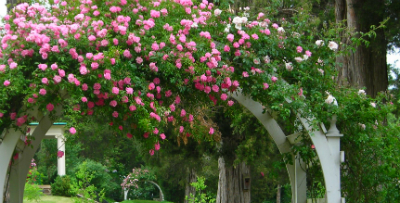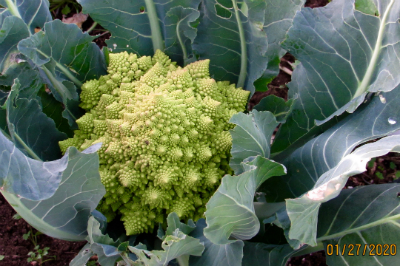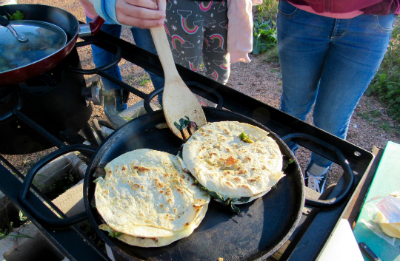
bringing nature, nurseries and gardeners together Feb 20, 2020
|
|
Free saplings: TreeFolks will give away Mexican buckeye, pecan, anacua, and dwarf pomegranates at this family-friendly event. Next Sat. (Feb 29) at the Elisabet Ney museum in Hyde Park. (304 E. 44th St) from 1 - 4 p.m. TreeFolks ❦

Antiques rose-show: I was probably not the only one at Mike Shoup's recent talk at the Natural Gardener who was inspired to return home and set to work tidying up their arbor - which he had declared (when draped with climbing roses) to be 'the ooh and the aah of everyone's garden.'
The tent was overflowing with rosarians at this chilly Saturday morning event, and Mike (Antique Rose Emporium) fired up everyone's enthusiasm for these tough, fragrant beauties. Plant them in a 30-50% mix of compost and soil for best results, he said, and nourish with mulch. (D.M.) Free class this Sat. (Feb 22) at 10 a.m.: Organic Veggie Gardening 201 with Stacie. Natural Gardener ❦
 
Free organic veggies: if you volunteer at Johnson's Back-yard Garden for half a day, they promise you will leave with a bounty of nutritious organic vegetables. JBG ❦
_________________________________________________
a d v e r t i s e m e n t
Thursday Morning Landscape
design and installation,
free consultation Call Dwight: 512 913 2189
_________________________________________________
Central Texas Gardener: On tour, a backyard fruit orchard replaced an old tennis court and limestone beds for food and flowers. In the studio Jay Arredondo (Desert to Tropics) pairs succulents of all kinds for eye-popping foliar and color combin-ations. Sat. 4 p.m. Sun. 9 a.m. KLRU ❦
 photo: Renee Studebaker
An Awe-inspiring Harvest
by Renee Studebaker
Now that we’ve gotten rain, there’s a lot to feel excited about in the winter garden at Smith Elementary. Sugar snap peas are blooming and setting tasty little green pods. The purple cabbages are forming heads, and the Chioggia beets are finally nearing harvest size.
But the most talked about cool weather crop has been the Romanesco (see photo above). From the moment the pointy little chartreuse head burst into view, it stood out as something different and awe-inspiring. “Look at this!” “What is it?” “Can I touch it?” “Are we going to eat it?” “I may not like it.” “Can I touch it again?” That kind of energy in response to a vegetable makes my heart sing. And now that I’ve learned a little about The Science of Awe, I’ve moved the Romanesco to the top of my “must grow” list. According to awe scientists, connecting with nature is one of the best ways to experience awe, which has been found to shift our attention away from ourselves, make us feel like we are part of something greater than ourselves, and make us more generous toward others. Of particular relevance here is the finding by physicist Richard Taylor and environmental psychologist Caroline Hägerhäll that observing fractals in nature has a soothing effect on the brain. (Fractals: the Atlantic)
After several weeks of ooh-ing and aah-ing about its weird shape and watching it grow, we finally harvested our big Romanesco and made quesadillas (see recipe below). This week, we’re watching one more Romanesco that’s almost ready to harvest. Meanwhile, I’ve noted on my Au-gust calendar to “start Romanesco seeds for the fall garden.” Next fall, I hope to have more than a dozen heads of Romanesco growing in the school garden. Won’t that be something awesome to talk about.❦

photo: Renee Studebaker
Romanesco, Kale and Black Bean Quesadillas 1/2 head of Romanesco* About 15 stalks of Lacinato kale 1 tbsp olive oil 1/4 medium onion, chopped 2 tbsp cilantro, chopped Salt and pepper to taste 1 tbsp tamari sauce 1-2 tsp Yellow Bird serrano sauce (or your favorite green hot sauce) Juice of 1 mandarin orange 2 tbsp black beans (cooked and rinsed) 3 tbsp grated monterey jack** 6 corn tortillas Remove stems and central ribs from kale and slice leaves into thin strips. Cut Romanesco into quarters and slice florets and stems into thin pieces. Add oil to large skillet over medium high heat. Add Romanesco, onion, pinch of salt and pepper, and sauté until tender crisp and lightly browned.
Stir in tamari, hot sauce, and orange juice; then add kale, cilantro and beans and sauté a few minutes more until kale is wilted and lightly caramelized. Remove kale mixture from heat.
Place 3 tortillas on a dry griddle (or large cast iron skillet) over medium heat. Spread generous portion of kale mixture on each tortilla, top each with 1 tbsp cheese (see note below), and place other 3 tortillas on top.
Cook until cheese is melted and bottom tortilla is lightly browned. Using a large spatula carefully turn each quesadilla and lightly brown the other side. Remove to a cutting board and slice quesadillas into wedges.
* White cauliflower can be substituted for Romanesco. ** For a vegan version, leave out the cheese. The slightly nutty, mild flavor of cooked Romanesco is a pretty good cheese replacement all by itself. Or try cashew cheese. ❦ Longtime Austin gardener and writer Renee Studebaker is a retired newspaper journalist who now teaches children how to grow and cook vegetables.
|
 It's About Thyme Legacy Publications.
Contact newsletter editor Darrel Mayers with any ideas for articles or interesting links at internationalrain@yahoo.com (hitting 'reply' to this email won't work) |
|
|